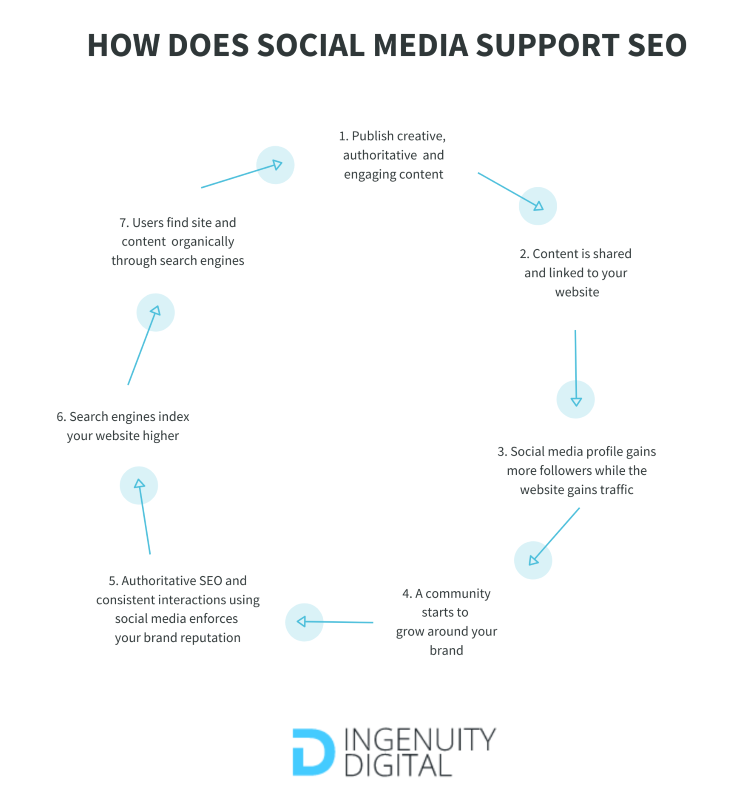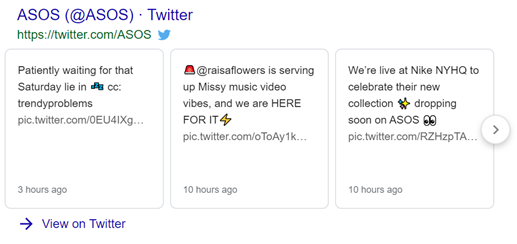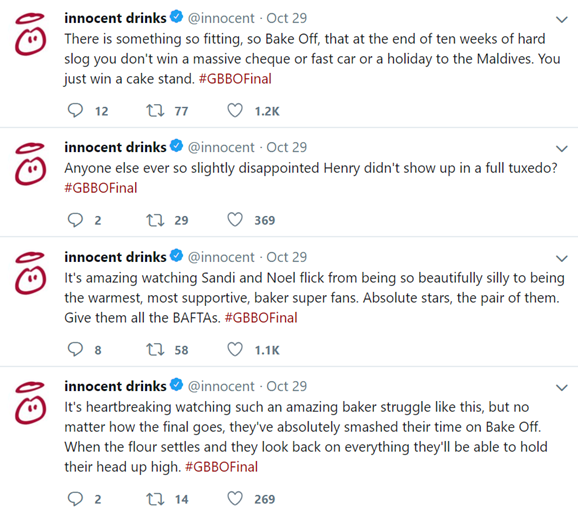Social Media: How Does It Impact Your SEO?
Social media can positively impact your business in a number of ways such as increasing brand awareness, building a loyal following and creating an online community. In addition to reaching your audience in their chosen space, social media activity can also indirectly influence SEO by driving traffic to your website and boosting engagement.
Although Google suggests social media is not a direct SEO ranking factor, there is sufficient research and evidence that shows social signals are, in fact, indirectly related to how your website ranks on Google in four primary ways:
- Increase online visibility and traffic to your website
- Increase brand recognition and Domain Authority (DA)
- Improve local SEO
- Increase content lifespan
Social media has the ability to not only make your SEO efforts more effective, but also more profitable. But how? Read on to find out more.
How is social media beneficial to SEO performance?
Driving brand awareness and traffic to your website
Social channels including Facebook, Instagram, LinkedIn, Twitter and Pinterest can increase brand visibility by attracting new followers to your platforms and new visitors to your website. Higher content reach through multiple shares, likes and engagement increases how much your content is seen, which all plays a key role in driving traffic to your site.
This, in turn, increases your ranking, placing your brand higher in the SERPs and boosting visibility. As a result, content reach increases along with the chance that more people will see and continue engaging with it. It’s essentially a cycle:

Google also crawls and indexes social media platforms in the SERPs. When crawling, the search engine does not take the number of followers into account. Even if you’re social channels are start-ups, as long as relevant, engaging and authoritative content is being shared, Google will use these signals to rank your profiles higher, helping to increase DA in the process. In fact, social media profiles can often be among the top results in branded searches. For example, when Googling fashion giant, ASOS, the company’s Twitter, Facebook and YouTube accounts appear as the 2nd, 3rd and 4th results.

Your brand should be capitalising on this by optimising your social media profiles. Enhancing social channels with relevant keywords across bios and captions increases visibility, helping shoppers find your business easier and encouraging them to click through to your social platforms. Branded hashtags have also become a method of cementing brand recognition and communities even further. The viral #ShareACoke campaign by Coca-Cola did this effectively, not only promoting their product, but also encouraging shoppers to use the hashtag, boosting brand awareness on a wider scale.
Create link-worthy content
Backlinks are significantly important to your website’s organic ranking, with the quality and quantity strongly impacting how well your site ranks. Focus your efforts on creating and sharing high quality content combined with effective social media marketing to generate more backlink opportunities.
When content gains traction through likes, shares and engagement, your visibility increases alongside the chance of relevant influencers, bloggers and brands wanting to connect and link out to your website. Outreach, blogging and influencer marketing continue to grow in popularity, with 22 percent of internet users aged between 18-34 now purchasing products after seeing influencer endorsements.
Social media can be used to boost outreach, particularly on Twitter. If your aim is to attract affluent bloggers, there are set hashtags which can be used including #bloggerswanted, #PRrequest and #journorequest. This is effective for reaching people outside of your following as content is essentially being shared in two separate spaces: yours and the influencer’s.
Increase your content’s shelf life
Did you know that 74 percent of users visit Facebook on a daily basis? That’s approximately 1.6 billion people consuming, engaging and sharing content every single day! These figures can work in favour of your website. Once a blog post, article or resource has been published, its lifetime depends on search engines and how regularly you update it. Unless users choose to visit your website and scroll back through pages of blogs, they are unlikely to see your previous content.
Social media helps prevent this, putting you in control of what’s being shared. You can effectively increase the lifetime of content by updating and reposting it across different channels. Content can also be targeted towards specific audiences on social media too, but remember, it’s important to target relevant audiences. Even the most engaging, insightful content won’t be shared if it’s seen by the wrong people.
What social media channels should you be using?
As a free method of driving traffic to your website, it’s important to use social media to the best of its ability. Building a community across these platforms can be tricky and needs a certain level of resource and knowledge to be effectively maintained. But when done right, the rewards can be significant. With many options available, it’s difficult to know which channels you should focus your efforts and budget on. The answer can vary based on your brand and your audience:
- B2B Businesses: As a business orientated platform, LinkedIn is where B2B businesses should be active. With nearly 660 million users worldwide, this is an effective networking and advertisement platform, particularly when it comes to PR. If your business has notable events or news to share, it’s a great platform to be noticed by publications and industry influencers. Facebook is also becoming a more prominent social media platform for businesses to advertise on. The channel amasses 2.41 billion monthly active users with impressive targeting and profiling capabilities making it an important advertising asset for businesses to utilise.
- B2C Businesses: In terms of placing yourself where your customers are, Instagram, Twitter and Pinterest are often the best choices for B2C brands. Instagram and Pinterest are heavily focused on visual, inspiration-based content such as trending fashion topics and interior look books. The recent addition of Pinterest’s new shopping features is putting the platform more in line with Instagram, creating a frictionless shopping experience. As for Twitter, we would advise using this channel from a customer service angle. The lifespans of tweets are very short, if a post goes viral, it’s great, but hard to achieve. Innocent use Twitter successfully, implementing the tactic of frequent, relevant content to maximise upon current user interests. For example, they produced 15 engaging tweets throughout the course of the Great British Bake Off (GBBO) final. Innocent were aware of the huge active audience who would be tweeting about the GBBO and by joining in with the online conversion, they were successfully raising their brand profile too:

Social media is a very powerful tool and shows no signs of slowing. Every day, people join different channels, making social signals more powerful than ever. If you want to harness the power of social media to benefit your SEO, your focus should be on generating link-worthy content and building a relevant social audience that you frequently engage with. Contact us today to find out how we can help you achieve this.